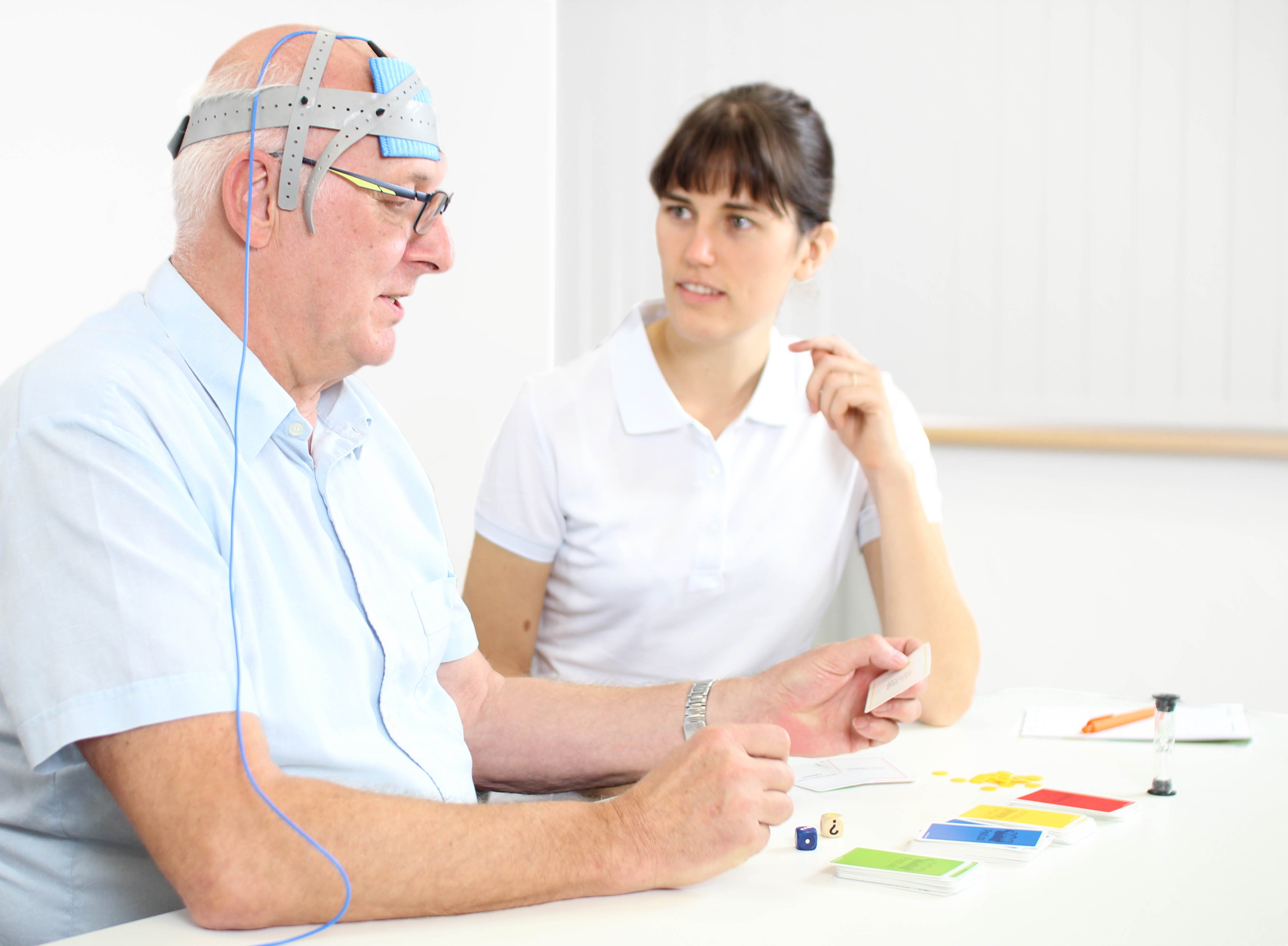tDCS for Aphasia
Learn more about the use of tDCS for Aphasia, how it works and the scientific evidence behind it.

Straight to:
Aphasia is a language disorder that can occur after a stroke, causing difficulties in speech production and comprehension. For some individuals, communication becomes extremely challenging due to the severity of the impairment. However, there is hope for improvement through a treatment called transcranial direct current stimulation (tDCS). By applying tDCS above the affected speech center, specifically the left temporal lobe known as Broca's area, speech production can be enhanced. Recent research has also shown promising and sustainable outcomes when using anodic tDCS over the motor cortex (M1). Even more encouragingly, combining tDCS with speech therapy has demonstrated further improvements in communication abilities, offering a potential pathway to help stroke patients recover their speech and language skills.
What is tDCS?
Transcranial Direct Current Stimulation (tDCS) is a non-invasive, well-tolerated neurostimulation treatment. In practice, tDCS involves attaching an anode and cathode electrode to the head producing a weak electrical current that is applied to the brain. Several studies have shown positive effects on a range of conditions. tDCS equipment is easy to use, and the treatment is painless and safe. When combined with other therapies, tDCS can enhance their positive effects. Depending on the voltage, duration, polarity, and location of the electrodes, the applied current has an inhibiting or stimulating effect. tDCS modifies the resting membrane potential, either promoting or inhibiting the transmission of information. This allows the therapist to modulate neuronal excitability and activity levels.

Why tDCS for Aphasia?
The rationale for investigating the use of transcranial direct current stimulation (tDCS) in aphasia lies in its potential to modulate cortical activity and enhance language recovery. Aphasia is a language disorder often caused by stroke or brain injury, leading to difficulties in speaking, understanding, and forming coherent sentences. Traditional therapies for aphasia focus on speech training and language exercises, but the recovery process can be slow and challenging.
tDCS offers a non-invasive and safe method to stimulate specific brain regions associated with language processing, such as Broca's area and Wernicke's area. By applying tDCS to these regions, researchers aim to enhance neural connections and promote neuroplasticity, which is the brain's ability to reorganize and form new pathways. This stimulation may improve language function, including word retrieval, sentence formation, and overall speech fluency.
Investigating tDCS in aphasia is driven by the need for more effective and innovative treatments to help individuals with language difficulties regain their communication abilities. By understanding the potential benefits of tDCS in facilitating language recovery, researchers aim to provide new therapeutic options and potentially improve the quality of life for those affected by aphasia.
Is tDCS for Aphasia scientifically proven?
tDCS has ‘Level C’ evidence as a treatment for Aphasia, which is considered to be ‘possibly effective’. At this level, evidence is derived from expert opinion, case studies, or standard practice. It carries the least weight in terms of scientific rigor, compared to Level A and B evidence, but may be used when higher levels of evidence are not available.
In a study by Meinzer and colleagues in 2016, researchers explored the use of tDCS to help patients with chronic aphasia. They used tDCS along with a type of therapy called "naming therapy." Naming therapy is a special kind of speech training where patients practice saying specific pictures or words repeatedly to improve their ability to name objects.
During the study, patients underwent intensive naming therapy with tDCS applied to a specific area of the brain called the left primary motor cortex. This area is connected to the language network in the brain and plays a role in speech production. The researchers chose certain pictures (items) that the patients couldn't name before the therapy (untrained items). They trained the patients to say these specific pictures repeatedly (trained items).
The results showed that the combination of naming therapy and tDCS significantly improved the patients' ability to name the trained items. Moreover, this improvement extended to other pictures (untrained items) that they hadn't practiced with, indicating that the therapy had a generalizing effect. These improvements were still present even six months after the therapy, suggesting that the benefits were long-lasting. This study shows that using tDCS with naming therapy could be a promising way to help stroke patients with chronic aphasia improve their language abilities.
In another study by Marangolo and colleagues in 2014, researchers wanted to see if tDCS could help improve speech in people with chronic non-fluent aphasia, a condition where individuals have difficulty speaking smoothly and coherently after a stroke. Eight participants took part in the study.
During the treatment, the participants watched short videos and described them while receiving tDCS to the left side of their brain in different areas related to language. After the treatment, they showed improvements in using connective words, like pronouns and conjunctions, which helped make their speech more cohesive. These positive effects were also seen in other speech tasks presented before and after the therapy. The study suggests that tDCS could be a helpful tool to promote language recovery and improve speech coherence in people with chronic aphasia.
Scientific articles on tDCS for Aphasia
Darkow R, Flöel A, Gleichstromstimulation in der Aphasietherapie, Neurologie und Rehabilitation 2018
Disclaimer
The information on this page is general in nature and is not intended to be a substitute for professional medical advice. Please speak with your doctor about your options for treatment.
tDCS Online Course
If you are a healthcare professional interested in learning more about tDCS, start with neurocare's online course on the LMS.
tDCS Devices & Accessories
*For Healthcare Professionals and Researchers Only.* Explore the neuroConn DC-STIMULATOR product range for clinical practice and research.
Find a clinic
Seek innovative and personalized treatment at a clinic near you
I’m a clinician
Learn more about our DTP, innovative technologies and training academy for health professionals.
I’m an investor
Learn more about our group and our mission to deliver innovative healthcare worldwide.
Stay up to date with our DTP & clinics
Stay up to date with our DTP & clinics
Copyright © neurocare group AG 2024
